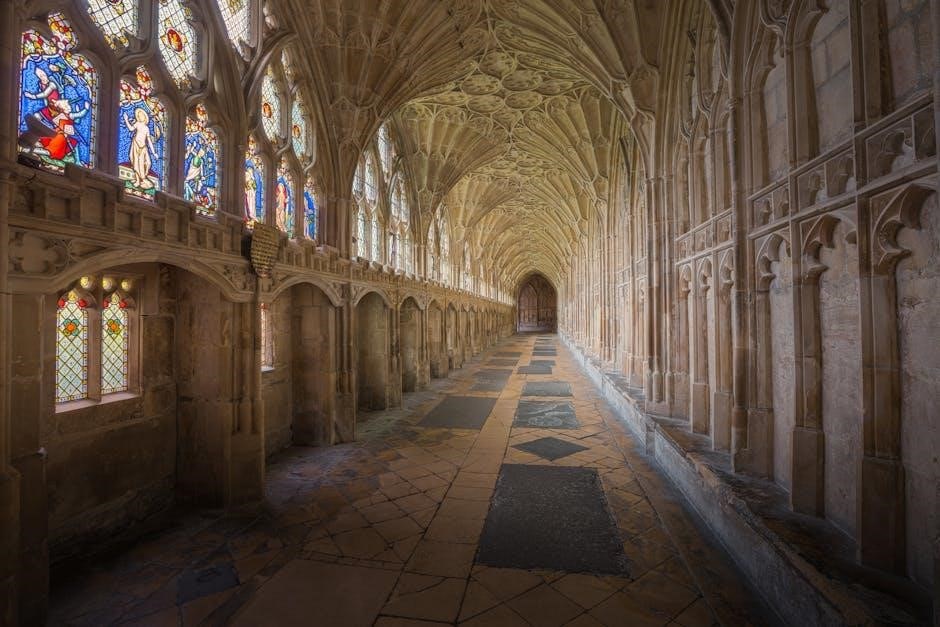Harry Potter and the Order of the Phoenix, the fifth book in J.K. Rowling’s series, explores Harry’s fifth year at Hogwarts amidst the Ministry’s denial of Voldemort’s return.
Overview of the Book and Its Significance in the Series
Harry Potter and the Order of the Phoenix is the fifth installment in J.K. Rowling’s iconic series, marking a pivotal point in Harry’s journey. The book explores his emotional struggles and growth as he faces the wizarding world’s disbelief in Voldemort’s return. It introduces the formation of Dumbledore’s Army, highlighting Harry’s leadership and resilience. The story delves into themes of rebellion, friendship, and the battle against oppression, setting the stage for the series’ climax. This book is crucial as it bridges the innocence of earlier stories with the darker, more complex tone of the later novels, showcasing Harry’s transformation into a mature leader. Its depth and emotional resonance make it a fan favorite and a cornerstone of the Harry Potter legacy.

Plot Summary
Harry’s fifth year at Hogwarts is marked by the Ministry’s denial of Voldemort’s return, leading to the formation of Dumbledore’s Army and a climactic battle at the Department of Mysteries.
First Plot Point: Harry’s Return to Hogwarts and the Ministry’s Denial
Harry returns to Hogwarts for his fifth year, only to find the wizarding community in denial about Voldemort’s return, with the Ministry dismissing his claims as lies. This denial creates tension, as many believe Harry is seeking attention rather than telling the truth. The Ministry’s refusal to accept the reality of Voldemort’s resurgence leads to the appointment of Dolores Umbridge as the new Defense Against the Dark Arts teacher. Umbridge’s ineffective teaching and oppressive regime further alienate Harry and his allies, setting the stage for the formation of Dumbledore’s Army. This plot point highlights the challenges Harry faces in a world that refuses to believe him, emphasizing his isolation and determination to act against the growing threat.
Themes and Symbolism
The novel explores themes of resistance, oppression, and internal conflict, symbolizing the struggle against darkness through unity and courage, while highlighting Harry’s emotional turmoil and growth.
The Power of Friendship, Loyalty, and Standing Up Against Oppression
Harry Potter and the Order of the Phoenix underscores the transformative power of friendship and loyalty in overcoming adversity. Harry, Ron, and Hermione form a resilient bond, standing united against the oppressive forces of Voldemort and the Ministry’s denial. The novel illustrates how their unwavering support for one another becomes a source of strength, enabling them to confront challenges that threaten their world. The formation of Dumbledore’s Army further exemplifies collective resistance, as students unite to challenge authority and fight for truth. This theme highlights the importance of solidarity and the courage to stand against oppression, even in the face of overwhelming odds and personal sacrifice.

Character Development
Harry’s emotional journey highlights his growth as a leader, navigating anger, isolation, and the burden of destiny, while learning the value of friendship and inner strength.
Harry’s Emotional Journey and Growth as a Leader
Harry’s fifth year at Hogwarts is marked by intense emotional turmoil, as he grapples with the denial of Voldemort’s return and the isolation it brings. His anger and frustration grow, exacerbated by the Ministry’s refusal to acknowledge the truth, leading to feelings of abandonment. Despite this, Harry learns to channel these emotions, becoming more determined and resilient. The formation of Dumbledore’s Army highlights his leadership skills, as he takes charge of teaching his peers defensive magic. This role not only strengthens his confidence but also deepens his understanding of the importance of unity and collective action against oppression. Through these experiences, Harry evolves from a troubled teenager to a steadfast leader, prepared to face the challenges ahead.

Major Events and Turning Points
The formation of Dumbledore’s Army and the Battle at the Department of Mysteries mark pivotal moments, showcasing Harry’s leadership and the escalating conflict with Voldemort’s forces.
The Formation of Dumbledore’s Army and the Battle at the Department of Mysteries
Harry forms Dumbledore’s Army to teach his classmates how to defend themselves against dark magic, as the Ministry denies Voldemort’s return and interferes with Hogwarts.
When the prophecy is revealed, Harry and his allies confront Death Eaters at the Department of Mysteries, leading to a fierce battle and the tragic death of Sirius Black.
This turning point highlights Harry’s leadership and the escalating conflict, marking a significant shift in the story’s tone and stakes for the young wizard and his allies.

The Ministry of Magic’s Role
The Ministry of Magic denies Voldemort’s return, interfering with Hogwarts and undermining Dumbledore, while its corruption and refusal to act escalate the wizarding world’s chaos and danger.
Denial of Voldemort’s Return and Its Impact on the Wizarding World
The Ministry of Magic’s refusal to acknowledge Voldemort’s return creates widespread chaos and mistrust. By denying the truth, they undermine Dumbledore and Harry’s warnings, leading to a divided wizarding community. Hogwarts is disrupted as the Ministry appoints Dolores Umbridge to suppress dissent. This denial emboldens Voldemort’s followers, allowing them to operate unchecked. The lack of action from the Ministry exacerbates fear and instability, while Harry’s isolation grows as few believe his claims. This period of denial ultimately weakens the wizarding world’s ability to unite against the growing threat, highlighting the dangerous consequences of ignoring reality.
The Battle at the Department of Mysteries
The climactic confrontation unfolds as Harry and his allies face Voldemort’s followers in a chaotic battle, centered around the Prophecy Orb, highlighting the conflict’s intensity and significance.
The Climactic Confrontation and Its Aftermath
The Battle at the Department of Mysteries reaches its peak as Harry and his allies, including the Order of the Phoenix, confront Voldemort’s Death Eaters. The prophecy orb, central to the story, is shattered, preventing Voldemort from obtaining its crucial information. Sirius Black’s tragic death at the hands of Bellatrix Lestrange leaves Harry devastated, intensifying his emotional turmoil and anger. Dumbledore’s subsequent duel with Voldemort showcases their immense magical prowess, ending with the Dark Lord’s escape. The aftermath reveals the Ministry’s forced acknowledgment of Voldemort’s return, marking a turning point in the wizarding world’s awareness. This confrontation underscores the escalating stakes and personal losses, deepening Harry’s resolve to confront the Dark Lord.
Reception and Impact
The book received widespread acclaim for its emotional depth and character development, with fans praising Harry’s growth and the story’s darker, more complex undertones.
Critical and Fan Reaction to the Book
Harry Potter and the Order of the Phoenix received widespread acclaim for its emotional depth and character development. Fans and critics praised the book’s darker tone, exploring themes of trauma, resistance, and the complexities of leadership. The story’s focus on Harry’s internal struggles resonated deeply, as did the introduction of Dumbledore’s Army and the epic Battle of the Department of Mysteries. Many noted how the book marked a significant shift in the series’ maturity, addressing the wizarding world’s denial of Voldemort’s return. The novel’s ability to balance action with introspection solidified its place as a fan favorite and a pivotal installment in the series.
